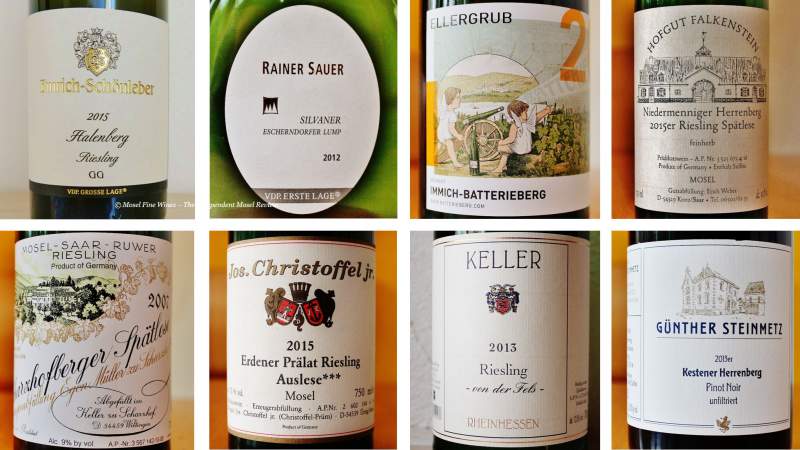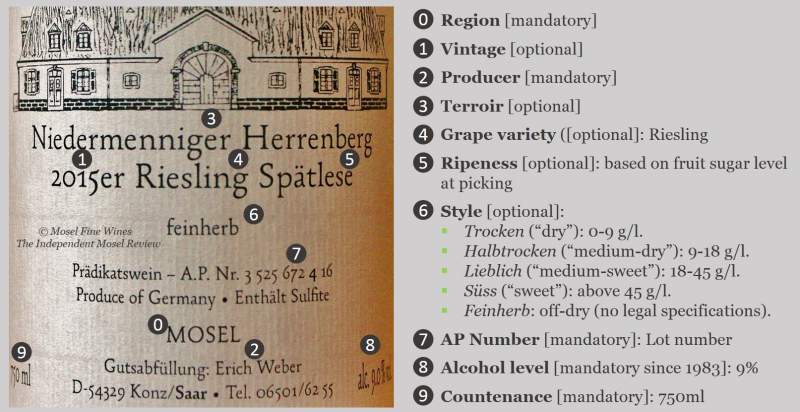
Deciphering what will be in your glass from a German wine label can be a frustrating experience. Here some basic rules of thumbs to help you achieve that.

The German wine labelling law is one of the most complete. It requires or allows to provide a whole set of information which goes beyond what is usually found in other countries.
However, German wine is also one of the most diverse, mainly due to the universal qualities of Riesling, which is both transparent to terroir and excels at all levels of sweetness (from bone dry to noble sweet).
It is therefore not unnatural that a wine labelling law that applies to a whole country with such a diversity as that of German wine requires a little bit of “learning.”
We share here a series of rules of thumb which, from our experience, cover 80% (if not more) of the cases. However, they are not foolproof: Where there are rules, there are exceptions.
The German wine label requires to provide or allows typically the following basic information on a label:

The issue with the German wine label is that the above information is either not fully used or incomplete for conveying some of the fine points of German wine, in particular Riesling.
So let us systematically walk through the different elements a wine lover wants to know and how he/she can learn it from the label.
Determining the vintage, the producer and the grape variety are pretty straightforward affairs as these can be read from the label. No vintage or grape variety indication respectively means multi-vintage or a blend.

Understanding the terroir, i.e. the origin of the wine, is also pretty straightforward once one grasps:
Although less to hardly used by quality growers, one needs to be wary that some seeming single vineyards such as Ürziger Schwarzlay are, in fact, a Grosslage, i.e. a sub-regional wine (which does not even need to contain a single grape from Ürzig).

German wine has a long history of specifying cask qualities, in particular but not only for sweet Riesling. However, words such as “feine” or “feinste” were prohibited after 1971. Growers had to recourse to indirect ways to communicate this.
As there was nothing in the law, different “systems” thrived. Three ways have crystalized over the years: The “golden capsule” (sometimes separated between golden and long golden capsules), the “star” system and an indication of cask numbers.
Some growers use a combination of these. In very rare cases, this differentiation is solely done via the AP Number. There are also a few Estates where such “indirect indicators” of quality have a different meaning (e.g. Markus Molitor and Peter Lauer).
Style (sweetness) can be the trickiest to assess as the words Trocken (dry), Halbtrocken (medium-dry) or Feinherb (off-dry), not to speak of the sweetness indicators Lieblich or Süss, are not always mentioned on the label.
In such a case, a look at the alcohol level will provide a rough indication: 12% usually means a dry or dry-tasting wine, 10% off-dry and 8% a fruity or even fully sweet.
However, this may not prove precise enough, among others when pairing with specific dishes. For such instances, a 4-step deductive approach based on a series of questions will help to almost unequivocally determine the sweetness level, in particular of a Riesling. This approach requires a little bit of background and is explained in the detailed article mentioned here below.
The matter of labelling for such a vast and diverse country as Germany is, by definition, complex. This is particularly the case because the German wine labelling law is all inclusive and not region-specific. The principles described above can therefore only serve as “80-20” rules of thumb.
A fully detailed article with explanatory notes, illustrative examples and a detailed Glossary explaining the meaning of the main words found on a German wine label was published in Mosel Fine Wines Issue No 34 (Apr 2017).
You are a subscriber and miss this Issue?
Simply send us a request by
email
and we will be happy to send you a copy.
You are not yet a subscriber and wish to get this Issue?
Subscribe free of charge by registering yourself here below and ask us for a copy by email.
© Text by Mosel Fine Wines "The Independent Review of Mosel Riesling ... and beyond!"
Disclaimer: Mosel Fine Wines is an independent publication and has no commercial relationship with any Estate, association or organization featured in this article.